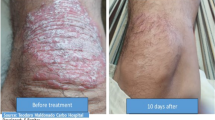Summary
The atrophogenic potential of medium-potent topical glucocorticoids is still controversial. In a double-blind controlled trial 24 healthy volunteers either applied 0.25% prednicarbate cream or the corresponding vehicle to one and 0.1% betamethasone-17-valerate cream or 0.05% clobetasol-17-propionate cream to the other forearm twice daily. Skin thickness was regularly assessed during the six week period of application and for further three weeks thereafter, using both the B- and A-mode of a 20 MHz ultrasound scanner.
Both betamethasone-17-valerate and clobetasol-17-propionate cream significantly reduced skin thickness as compared to cream base while prednicarbate cream did not.
Given that 0.1% betamethasone-17-valerate- and 0.25% prednicarbate cream are reported to be about equipotent in the treatment of atopic eczema the latter preparation shows an increased ratio between its desired anti-inflammatory and its unwanted atrophogenic effect.
Similar content being viewed by others
References
Epstein NN, Epstein WL, Epstein JH (1963) Atrophic striae in patients with inguinal intertrigo. Arch Dermatol 87: 450–457
Takeda K, Arase S, Takahashi S (1988) Side effects of topical corticoids and their prevention. Drugs 36 [Suppl 5]: 15–23
Töpert M (1988) Perspectives in corticosteroid research. Drugs 36 [Suppl 5]: 1–8
Hevert F, Schipp I, Busch B, Rozman T (1989) Kortikosteroid-Ester. Dtsch Derm 37: 678–683
Vogt HJ, Höhler Th (1988) Controlled studies of intraindividual and interindividual design for comparing corticosteroids clinically. In: Christophers E, Schöpf E, Kligman AM, Stoughton RB (eds) Topical corticosteroid therapy. Raven, New York, pp 169–180
Schröpl F, Schubert Ch (1988) Long-term study on local steroids using the example of prednicarbate. In: Christophers E, Schöpf E, Kligman AM, Stoughton RB (eds) Topical corticosteroid therapy. Raven, New York, pp 155–168
Tan C, Marks R, Payne P (1981) Comparison of xeroradiographic and ultrasound detection of corticosteroid induced dermal thinning. J Invest Dermatol 76: 126–128
Dykes PJ, Hill S, Marks R (1988) Assessment of the atrophogenicity potential of corticosteroids by ultrasound and by epidermal biopsy under occlusive and nonocclusive conditions. In: Christophers E, Schöpf E, Kligman AM, Stoughton RB (eds) Topical Corticosteroid Therapy. Raven, New York, pp 111–118
Lubach D, Grüter M (1988) Vergleichende Untersuchungen über die hautverdünnende Wirkung von Amcinonid and Prednicarbat an unterschiedlichen Körperregionen des Menschen. Akt Dermatol 14; 197–200
Søndergaard J, Serup J, Tikjob G (1986) Ultrasonic A- and B-scanning in clinical and experimental dermatology. Acta Dermatovenerol (Stockh) [Suppl] 120: 76–82
Author information
Authors and Affiliations
Rights and permissions
About this article
Cite this article
Korting, H.C., Vieluf, D. & Kerscher, M. 0.25% Prednicarbate cream and the corresponding vehicle induce less skin atrophy than 0.1% betamethasone-17-valerate cream and 0.05% clobetasol-17-propionate cream. Eur J Clin Pharmacol 42, 159–161 (1992). https://doi.org/10.1007/BF00278477
Received:
Accepted:
Issue Date:
DOI: https://doi.org/10.1007/BF00278477




